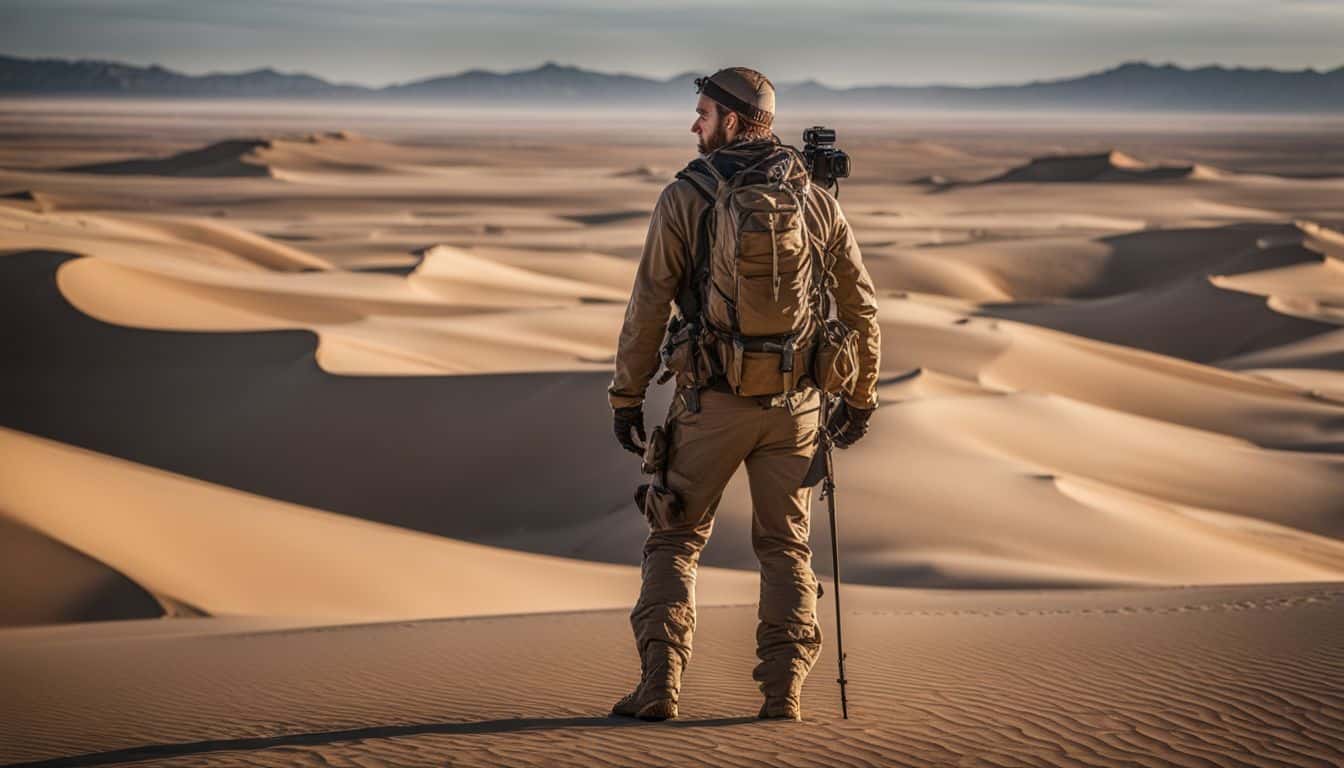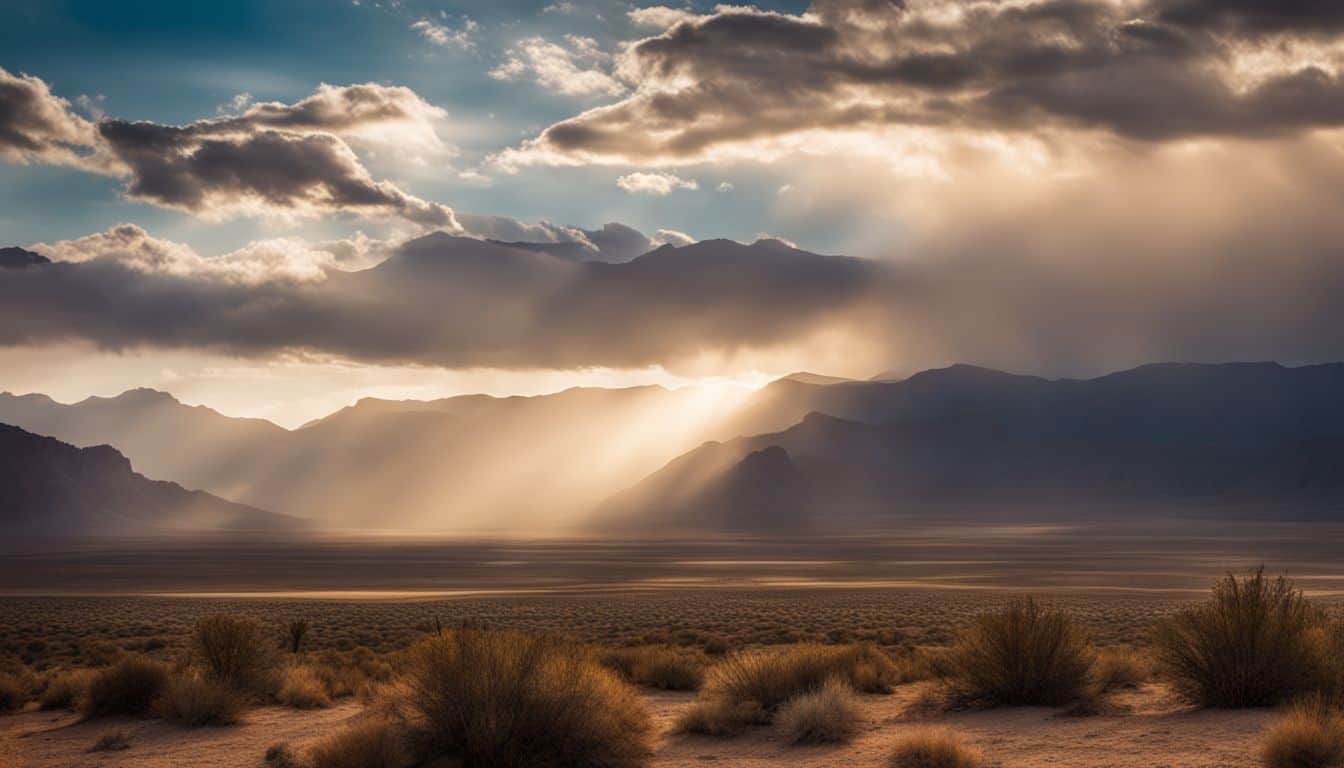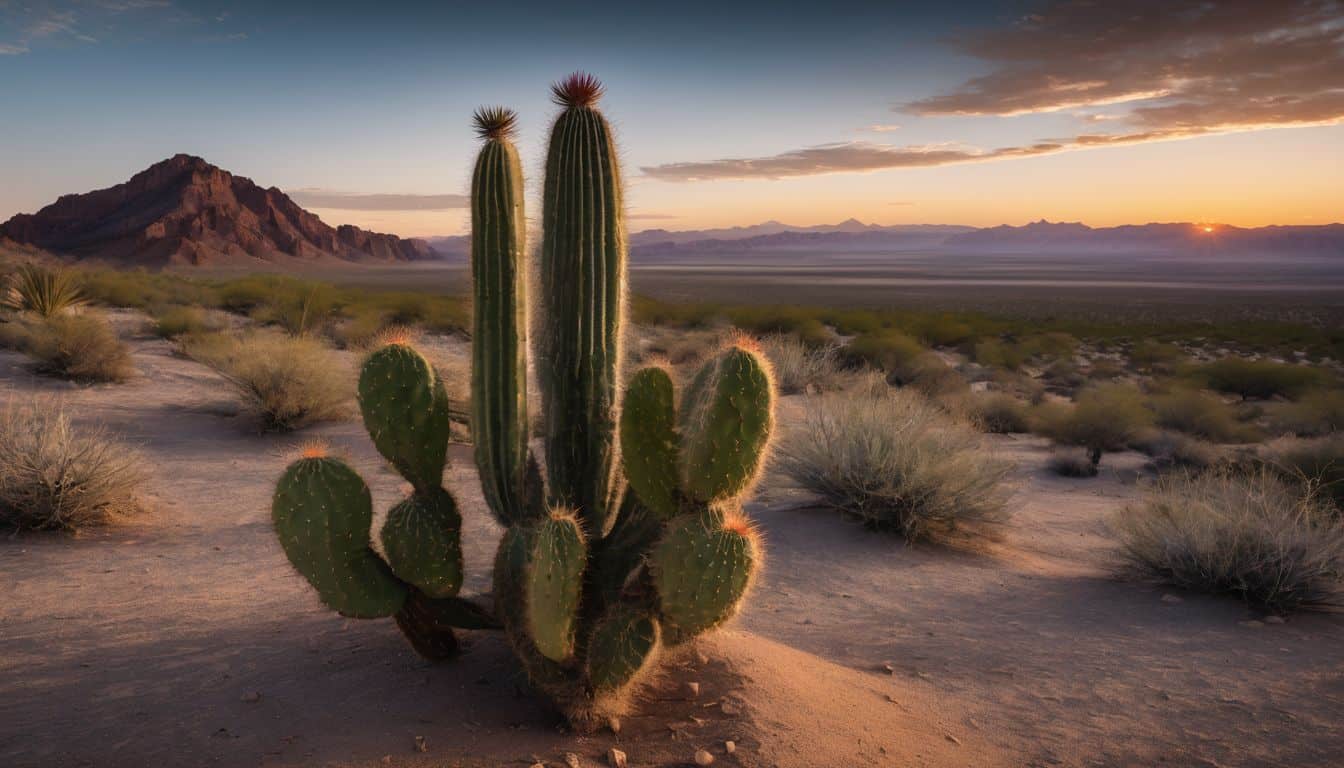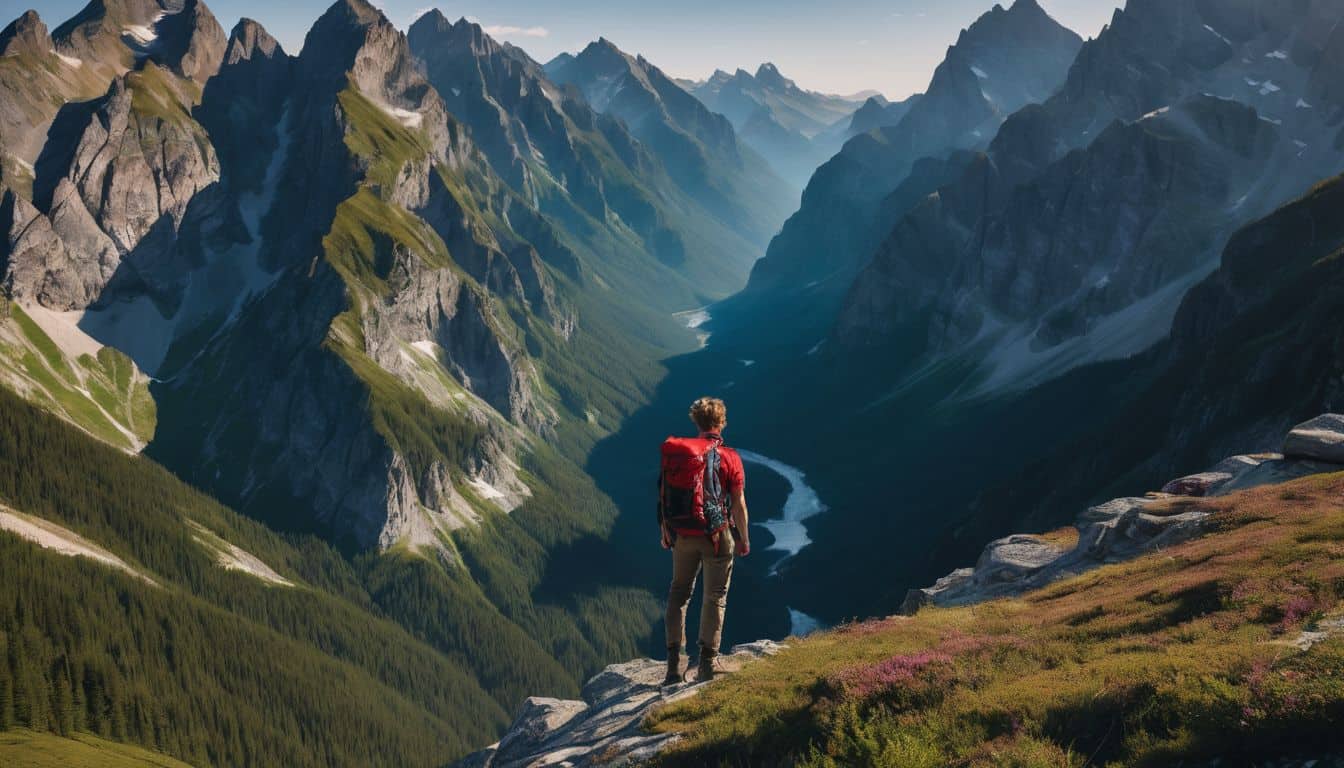Are you ready to embrace the thrill of a desert adventure, or maybe you’re just fascinated by desert survival tips and skills? Believe me when I say, finding yourself alone in a desert is not exactly a picnic.
In fact, NASA has shared studies indicating that daytime temperatures can shoot up to an astonishing 120 degrees Fahrenheit! This blog is your go-to guide; detailing nine essential strategies to help you stay safe and even flourish amidst relentless heat and barren landscapes.
So are we set to conquer these sandy expanses together? Let’s dive right in!
Key Takeaways
- Choose the right gear: Wear light-colored clothes, pack water purification tablets, and carry a first aid kit and compass.
- Respect the heat: Protect yourself from the sun by wearing sunscreen, seeking shade, staying hydrated, and wearing light-colored clothing.
- Understand desert survival basics: Be prepared with a plan, stay calm and focused, conserve energy and water wisely, and seek cover from intense sunlight.
- Find water in the desert: Look for natural sources of water like vegetation or animal activity, collect morning dew using cloth or rocks, and know where to find hidden pockets of moisture.
- Preserve sweat instead of drinking too much water: Eat foods with salt and potassium to retain more water in your body while preventing excessive sweating.
Gear for Desert Survival
When preparing for desert survival, it is crucial to have the right gear that will help you withstand the harsh conditions.
Clothing
In the desert, your clothing is key to staying safe. Light-colored cotton clothes are best because they don’t absorb as much heat from the sun. Long pants and long-sleeved shirts shield your skin from harsh rays.
Just like Bedouins use camel, sheep, and goat wool for their attire, you also need breathable fabrics when hiking in a desert climate. Don’t forget a head cover! Traditional desert headwear works well too; it gives UV protection and keeps you cool at the same time.
So always pack your gear with suitable desert clothing styles before stepping out into hot sand dunes.
Water
I always pack water first. It is the most vital part of my desert survival kit. If I lose it or run out, I know how to find more in the arid sands. One way is by digging in dry riverbeds or finding potholes hidden away from the sun.
Once found, the water must be safe to drink. Dirt and bugs can make it bad for me but there’s a fix! Water purification tablets clear up any problems like this with ease. Keeping these facts in mind helps ensure survival even when faced with scarcity in a harsh desert.
Food
Staying strong in the desert needs more than just water. Food is also key. By eating foods with salt and potassium, I can fight heat exhaustion and hold in more water. I pack basic food supplies like nuts, seeds, dried fruits for needed energy boosts.
Hunting small desert wildlife or picking safe, edible plants can also offer me extra bites to eat when moving about. The outdoor survival rule of three helps me remember this: shelter first, then water and last food – all crucial parts of my desert survival kit.
Tools
Carrying the right tools is crucial for surviving in the desert. In my experience, a well-equipped emergency kit is a must-have. It should include items like a sturdy knife or multi-tool, water filtration tablets, and fire starting tools.
A directional compass is also essential for navigation since GPS may not always work reliably in the desert. I recommend investing in a lightweight backpack where you can store all these items comfortably, as carrying them around will reduce fatigue while hiking.
Trust me, having the right tools can make all the difference in your desert survival journey.

First Aid Kit
Having a first aid kit is crucial when exploring the desert. It’s important to be prepared for any injuries or emergencies that may occur. In your first aid kit, make sure you have basic supplies like bandages, gauze, antiseptic wipes, and pain relievers.
These will come in handy for treating cuts, scrapes, and minor wounds. Additionally, include specialized items specifically for desert survival such as blister treatment, snake bite kits, and dehydration prevention supplies.
Remember to prioritize the contents of your first aid kit based on recommendations from wilderness and military medicine experts. Stay safe and be prepared!
Navigation
Navigation in the desert is crucial for survival. As a survival enthusiast, I understand the importance of being able to find your way in unfamiliar terrain. In the vast expanse of sand dunes and extreme heat, it can be easy to get disoriented and lose your bearings.
That’s why it’s essential to have some basic navigation skills up your sleeve.
One traditional method used by nomads and Bedouins in the desert is tracking footprints and following animal tracks. By studying these imprints in the sand, they can determine which direction others have traveled before them, leading them towards potential sources of water or civilization.
Another useful technique is using rocks and shadows as makeshift sun compasses. Paying attention to how shadows change throughout the day can help you identify east from west, providing a rough sense of direction.
However, relying solely on these methods may not always be foolproof. That’s why carrying a compass should be an essential part of your gear for desert survival. GPS devices may not always work reliably due to factors like signal interference or battery life.
Respect the Heat
Protect yourself from the sun by wearing light-colored clothes.
Protect Yourself from the Sun
The sun in the desert can be extremely hot and dangerous. To stay safe, I suggest following these tips:
- Wear sunscreen to protect your skin from harmful UV rays.
- Seek shade whenever possible to avoid direct exposure to the sun.
- Stay hydrated by drinking plenty of water throughout the day.
- Wear a hat or cap to shield your face and head from the sun.
- Use sunglasses with UV protection to protect your eyes from the bright sunlight.
- Cover up your body with lightweight, loose – fitting clothing to minimize sunburn and heat exhaustion.
- Avoid staying outside during the hottest parts of the day, usually between 10 am and 4 pm.
Wear Light-Colored Clothes
In the desert, it’s important to wear light-colored clothes. Light colors reflect more heat, which can help keep you cooler in the hot sun. Dark colors, on the other hand, absorb more light and radiate heat faster.
By wearing light-colored clothes, you can lessen your skin exposure to sunlight and reduce the risk of overheating. So, when you’re out in the desert, make sure to cover up with light-colored clothing to stay comfortable and protected from the intense heat.
Understanding the Basics of Desert Survival
Survival in the desert can be challenging, but with some basic knowledge and preparation, you can increase your chances of making it through. One important aspect is understanding the basics of desert survival.
This includes being prepared for the worst-case scenario, staying calm and focused, conserving energy and water, and seeking cover when needed.
Being prepared means having a plan in place before heading into the desert. This includes letting someone know about your plans and expected return time so that they can check on you if necessary.
It’s also essential to have a map or GPS device to navigate accurately and avoid getting lost.
Staying calm and maintaining a positive mental state is crucial for surviving in the desert. Panic control is vital because making rational decisions during high-stress situations can save lives.
Keeping busy by focusing on tasks like finding water or building shelter can help distract from fear or anxiety.
Conserving energy is another key aspect of desert survival. The extreme heat of the desert quickly drains energy levels, so it’s important to rest frequently, especially during the hottest parts of the day.
Preserving sweat instead of drinking too much water helps keep hydration balanced because excessive sweating leads to dehydration.
Seeking cover from intense sunlight is essential for avoiding heatstroke or sunburns. Finding shade under rocks or using materials like tarps or blankets to create shade structures will protect you from direct exposure to the sun’s rays.
Understanding these basics will provide a solid foundation for surviving in the harsh environment of the desert. By being prepared, staying calm, conserving energy and water wisely, as well as seeking cover when needed, you increase your chances of successfully navigating this extreme wilderness.
Finding Water in the Desert
Finding water in the desert is crucial for survival. Learn about natural sources of water, collecting morning dew, and knowing where to look. Don’t miss out on these essential tips!
Natural Sources of Water
In the desert, finding water can be a real challenge. But there are some natural sources of water that you can look out for. Vegetation, like trees and bushes, can indicate that there might be water nearby.
Birds and insects also tend to gather around these areas because they need water too. Underground sources of water can exist in the form of springs or underground rivers. So if you see any signs of vegetation or animal activity, it’s worth investigating further to find these hidden water sources.
Proper management and conservation of these precious resources is crucial to prevent scarcity and ensure sustainability in arid regions.
Collecting Morning Dew
Morning dew is a valuable source of water in the desert. Here are some ways to collect it:
- Use a cloth: Pass an absorbent cloth over vegetation before dawn and squeeze it out to collect the dew.
- Look under rocks: Turning over rocks in the early morning may reveal dew that can be collected as a water source.
- Utilize tarps or shoes: Placing tarps or shoes outside overnight can gather dew that can be collected in the morning.
Knowing Where to Look
To survive in the desert, knowing where to find water is crucial. Water scarcity is a major challenge in the desert, but there are ways to locate this life-saving resource. One method is to look for natural sources of water such as springs, oases, or dry riverbeds.
These areas may have hidden pockets of moisture that can be tapped into. Another technique is collecting morning dew by placing absorbent material like clothing or plants on the ground overnight and wringing out the collected moisture in the morning.
Additionally, observing wildlife can also lead you to water sources since animals need water to survive too. Keep an eye out for birds flying overhead or animal tracks heading in a particular direction as they might be leading towards a nearby source of water.

Preserve Sweat, Not Water
Preserving sweat is crucial when you’re in the desert. In this survival situation, it’s more important to keep your body cool than to conserve water. When our bodies sweat, it helps us stay cool in the scorching heat.
So instead of trying to save every drop of water, focus on preventing excessive sweating and dehydration. By eating foods that contain salt and potassium, you can retain more water in your body and avoid heat exhaustion.
Rationing your sweat, rather than rationing water, is a key strategy for surviving in the harsh desert environment. Remember, it’s all about maintaining electrolyte balance and staying hydrated while preserving precious moisture by keeping sweating under control.
dehydration
Make a Fire
To make a fire in the desert, gather enough firewood, utilize the right kindling, and create a proper fire structure for maximum efficiency and heat.
Gather Firewood
To make a fire in the desert, finding dry firewood is crucial. Using wood that is bone dry will increase your chances of success when starting a friction-based fire. If the wood you find isn’t completely dry, take some time to dry it out before attempting to start a fire.
When gathering firewood, remember not to cut whole trees or branches. It’s important to avoid damaging the forest and conserving live materials that won’t burn anyway. Choose your spot for a fire carefully, especially in a desert survival situation where resources may be limited.
Utilize the Right Kindling
To start a fire in the desert, it’s important to utilize the right kindling. Kindling is the small, dry materials that help ignite the fuel and sustain the flames. It’s not just about using thin or split wood kindling – there are other options too! In fact, different types of tinder and kindling can be used to get your fire going.
The key is to make sure that whatever you choose is dry and ready to burn. Remember, in the desert, moisture can be hard to come by, so ensuring your kindling is as dry as possible will increase your chances of success.
Gathering three times more kindling than you initially estimate can also improve your odds of starting a fire successfully. So don’t underestimate its importance when building a fire in the desert!
Create a Proper Fire Structure
Building a proper fire structure is essential for survival in the wilderness. It’s important to gather firewood, making sure it’s dry and easily ignitable. Using small sticks or twigs as kindling can help start the fire, while larger logs can be used to maintain it.
Building a teepee-like structure with the kindling will allow air to flow through and help the fire burn efficiently. Remember that being grounded and relaxed with a clear mind can increase your success in creating a fire.
Practice this skill in your backyard to refine it further. Fire building is not only practical but also acts as an internationally recognized distress signal when three fires are set up in a triangle formation.
Keeping Your Energy Levels Up
To keep your energy levels up in the desert, it is important to eat light and often. Avoid sugary foods that can cause a spike and then crash in your energy levels. Instead, opt for snacks that are high in protein and fiber to provide sustained energy throughout the day.
Learn more about essential tips for desert survival by reading the full blog post!
Eating Light and Often
When surviving in the desert, it is important to eat light meals frequently. This helps to keep your energy levels up and maintain stamina throughout the day. By snacking frequently, you can provide your body with a steady stream of fuel, preventing energy crashes.
It is essential to ensure that your snacks are balanced and nutritious, providing you with the vitamins and minerals needed for endurance in harsh conditions. Additionally, eating light meals can help with water retention in the desert, as digesting heavy meals requires more water.
Choose foods that are high in energy, such as nuts, dried fruits, granola bars, and jerky. These foods provide sustained fuel and can help prevent heat exhaustion while improving your chances of success in desert survival situations.
Avoiding Sugary Foods
Maintaining energy levels is crucial when surviving in the desert, and avoiding sugary foods can help with that. While sugar may give you a quick burst of energy, it can cause your blood sugar levels to spike and then crash, leaving you feeling tired and depleted.
Instead, focus on eating nutrient-rich foods that provide sustained energy throughout the day. Opt for a balanced diet with plenty of fruits, vegetables, whole grains, lean proteins, and healthy fats.
Natural sweeteners like honey or maple syrup are better alternatives to refined sugars. By being mindful of your food choices and opting for low glycemic index foods that release energy slowly into your system, you’ll be able to maintain stable energy levels during your desert survival journey.
Avoid Eating Cacti
Eating cacti can be dangerous because most of them are poisonous. Even though the fruit may seem tempting, it’s generally safe to eat. But you should never open up a cactus and try to drink the pulp inside because that part is harmful.
The spines on a cactus can also cause harm if they get into your mouth or throat. So, it’s better to avoid eating any part of a cactus to stay safe in the desert.
Stay off the Ground
Staying off the ground is really important when you’re in the desert. It can help keep you safe and comfortable. When you’re on the ground, it can be really hot because it retains and radiates heat.
This can make you feel even hotter than the air temperature. Plus, the sand can burn your skin and make you dehydrated. So, try to sleep on elevated platforms or use a hammock if possible.
By staying off the ground, you’ll also reduce your chances of encountering insects, snakes, and other dangerous creatures that live in the desert.
How to Stay Safe in the Desert
Know the signs of dehydration, be aware of dust storms, prepare for desert emergencies, avoid unsafe situations, and pay attention to changes in the weather.
Know the Signs of Dehydration
Dehydration is a serious problem when you’re in the desert. Without enough water, your body can’t function properly. That’s why it’s important to know the signs of dehydration so you can stay safe.
Thirst is an obvious sign that you need water, but there are other signs too. If your mouth feels dry, if you feel tired or dizzy, or if you have a headache, these could be signs of dehydration.
It’s also important to pay attention to changes in your urine – if it becomes dark yellow or amber in color, that means you need more fluids. Dehydration can lead to heat exhaustion and even heat stroke, which are both very dangerous.
Be aware of Dust Storms
Dust storms can be dangerous when you’re in the desert. They usually don’t last long, but they can cause problems if you’re not prepared. Dust storms are caused by strong winds blowing over dry, sandy areas.
When a dust storm is approaching, cover your face to protect yourself from breathing in the dust. The dust particles can irritate your eyes and make it hard to breathe. So, if you see a dust storm coming, take shelter and cover up as much as possible to stay safe from the swirling clouds of dust.
Prepare for Desert Emergencies
It’s important to be prepared for emergencies when you’re in the desert. Here are some tips:
- Share your plans: Before heading into the desert, make sure someone knows where you’ll be and when you expect to return.
- Carry a map and compass: Knowing how to navigate is crucial if you get lost. Always have a map and compass with you.
- Pack a signaling device: In case of an emergency, it’s essential to have a way to signal for help. Bring items like a whistle or a mirror.
- Have a first aid kit: Accidents can happen anywhere, so be prepared with a well-stocked first aid kit that includes items like bandages, antiseptic ointment, and pain relievers.
- Bring extra food and water: Always pack more than you think you’ll need. In case of unexpected delays or emergencies, having extra supplies can be lifesaving.
- Know the emergency phone numbers: Make sure you know the local emergency phone numbers in case you need assistance in the desert.
- Stay calm and conserve energy: In an emergency situation, it’s crucial to stay calm and think clearly. Conserve your energy by resting when needed and avoiding unnecessary exertion.
- Create shade: If you find yourself stranded without shelter, try to create shade using available resources like clothing or branches.
Avoid Unsafe Situations
To stay safe in the desert, it’s important to avoid unsafe situations. One way to do this is by informing others of your itinerary before heading out into the desert. This way, if something goes wrong, they’ll know where to find you.
Another tip is to avoid hiking in extreme heat, especially during the hottest part of the day. Instead, plan your activities for early morning or evening when it’s cooler. Seek shelter in shaded areas and try to stay out of direct sunlight during peak hours.
It’s also a good idea to pay attention to changes in the weather and be aware of dust storms that can appear suddenly in the desert. By taking these precautions and being cautious about your surroundings, you can help ensure a safer desert survival experience.
Pay Attention to Changes in the Weather
Changes in the weather are crucial to pay attention to when you’re trying to stay safe in the desert. The desert climate can be extreme, with hot temperatures and sudden shifts in weather patterns.
It’s important to be prepared for these changes so that you can protect yourself from potential dangers. For example, sandstorms, flash floods, and dust devils are all possible weather events that can occur in the desert.
By paying attention to changes in the weather forecast and being aware of your surroundings, you can take necessary precautions and ensure your safety while exploring the desert.
Conclusion on Desert Survival Tips
In conclusion, it’s important to respect the heat and take precautions to protect yourself from the sun. Remember to stay hydrated by drinking water regularly but avoiding drinking all of it at once.
Don’t eat cacti and try to find natural sources of water in the desert. Keep your energy levels up by eating light and often, and avoid sugary foods. Lastly, stay safe by knowing the signs of dehydration, being aware of dust storms, preparing for emergencies, avoiding unsafe situations, and paying attention to changes in the weather.
With these tips in mind, you can increase your chances of success in desert survival.
FAQs on Desert Survival Tips
1. What are some essential items to have for desert survival?
Essential items for desert survival include water, a shelter or tent, sunscreen, a hat, and proper clothing to protect against the sun.
2. How can I find water in the desert?
Look for signs of vegetation or wildlife as they may indicate the presence of water nearby. You can also dig shallow holes in dry creek beds or use solar stills to extract moisture from plants.
3. What should I do if I get lost in the desert?
If you get lost in the desert, stay calm and try to retrace your steps back to familiar landmarks or follow any visible trails. If unable to find your way back, signal for help by creating visual markers or using a whistle.
4. How can I protect myself from extreme heat in the desert?
To protect yourself from extreme heat in the desert, wear loose and lightweight clothing that covers your skin, use sunscreen with high SPF, drink plenty of water regularly, and rest in shaded areas when possible.
5. What should I do if encountering dangerous wildlife while navigating through the desert?
When encountering dangerous wildlife while navigating through the desert, it’s important not to approach them and give them space. Stay calm and slowly back away without turning your back on them.





Leave a Reply